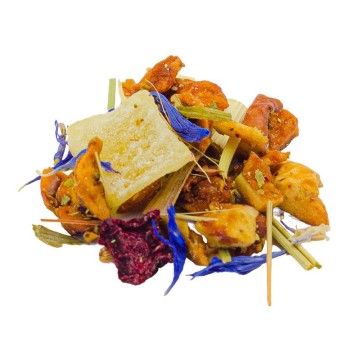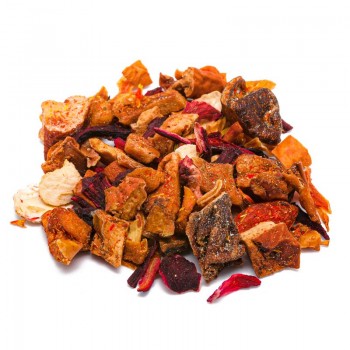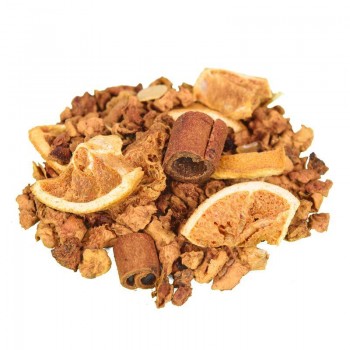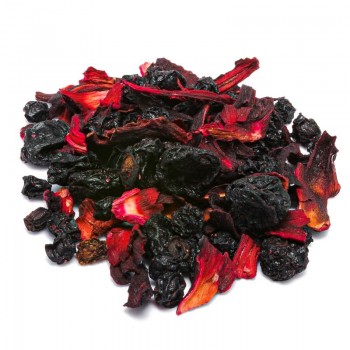Typical of Italian and European mountain areas, mulled wine has been used for centuries as an invigorating and warming agent during the coldest days. It is a warm and aromatic red wine drink considered an ancient health remedy suitable for adults, as it is alcoholic. We know that to create an excellent mulled wine to quality red wine, usually full-bodied and still, aromas must be added through spices, citrus peel and berries. The convenient blend that we offer features various natural foods that help to flavor the recipe - pleasant as a "cuddle", to be sipped on winter days, it perfumes the house in a wonderful way.
Infusion of mulled wine: properties and benefits
Our proposal for the preparation of the drink also represents a useful contribution to well-being with natural ingredients of nutritional value, as well as delicious. This hot spiced wine is not just a Christmas drink, but has also been known for its healthy properties over the centuries. Not only the classic grandmother's remedy but a blend rich in virtues for the well-being of the organism. Mulled wine fights low temperatures, which can cause problems for our body and respiratory tract, on freezing evenings. Once upon a time, when we met in the open air in winter, we warmed up with mulled wine. In our mulled wine infusion we insert apple, hibiscus flowers, elderberries, orange, cinnamon peel, cloves and natural flavors. If some ingredients are useful above all for flavoring, such as cloves and cinnamon, others have qualities useful for digestion and to counteract colds. As an ancient natural cold remedy, it uses the ingredients polyphenol antioxidants to improve vasodilation. Among its properties, in addition to its warming properties, mulled wine is a disinfectant drink that combines alcohol with some purifying spices. Cinnamon and cloves with natural antibacterial properties (due to cinnamaldehyde), can promote defenses against flu states, helping people with colds. At the same time, the tannins present in the wine help fight colds and coughs. Elderberry improves blood circulation and, traditionally, the berries were considered to have natural anti-inflammatory properties, useful for relieving rheumatic pain (thanks to the anthocyanins). Mulled wine is tonic, it gives energy but without the effects of excess alcohol. This happens because boiling causes some of the alcohol content in the wine to be lost, which evaporates. In the blend of herbs and spices for mulled wine, the orange serves to dampen the too intense tone of the wine and releases the maximum aroma in contact with the flavour. This also applies to other elements of the mulled wine brew such as cinnamon and cloves. They release their perfume, giving a warm and pungent sensation, intense on the palate. How to use the ingredients to prepare mulled wine You take a saucepan, large enough for your needs. Pour 2 liters of red wine into the container. Stir and bring to the boil (about 70-80°C). Add 100 grams of sugar, which is dissolved. Add 2 tablespoons of the mixture to the mulled wine infusion. Continue over low heat for about 5 minutes to allow the alcohol to evaporate. Be careful not to boil the wine, it alters the flavor. In the traditional recipe, alcohol vapors are set on fire with a match - to give a smoky or burnt flavor (brulé). Once the flames have gone out, the pot is removed from the heat, then filtered and poured into a container or jug. It must be served still hot, to enhance the aroma. A heavy, enamelled container is recommended, which retains the heat of the wine well once it is ready. As for the type of wine, a full-bodied and fruity red is recommended, but not of high quality. Many prefer cabernet sauvignon, cheap merlot, a sangiovese or a negroamaro. You can adjust the sweetener according to taste, and some also add 1 tablespoon of other distillates such as rum, brandy, cognac, etc.
Origins and history of mulled wine
This hot wine is perhaps the evolution of a drink born in Greece: wine sweetened with honey, heated and flavored with pepper, saffron, spikenard leaves and sweet dates. It was described by the Roman Apicius as Conditum Paradoxum in the 1st century AD. Already in Roman times, in fact, the so-called spiced wine was consumed in large quantities. Spices were useful for better preserving the nectar of Bacchus, and the tradition was then reused in convents to warm up the coldest evenings. In the Middle Ages it became a traditional hot drink of thewinter in Northern Italy and throughout Northern Europe. Some spices and ingredients were added to the heated wine, according to the traditions and availability of the country of origin. Mulled wine (that is burnt wine), has had great success in the silence of convents, also for its therapeutic qualities studied by the monks. Its popularity in the Middle Ages also made it the subject of various recipes, with different medicinal herbs. In France, it was still widespread in the 19th century as the wine of "street poets", who warmed up in bars or outside, with their "vin brûlé". It is curious that while in Italy the French word mulled wine is used, in France it is known as vin chaud (hot wine). Even today, mulled wine is very popular from the end of November onwards, in the squares of Northern Italy and above all in the Christmas markets. The warm, spiced wine is usually served in ceramic cups, prepared in a large pot and then poured into tankards when guests arrive. The custom of spiced wine is also widespread throughout Europe and North America, traditional in winter from the Advent period up to Carnival.
Plant and flowers
The components of the infusion are many, and the mix includes leaves, fruits and flowers of different origins. To create this infusion, the following have been used: apple pieces, hibiscus flowers, elderberries, orange pieces, cinnamon peel, cloves, natural flavourings. The Malus domestica plant of the Rosaceae family gives the apple fruit. It is a tree native to Asia, now spread all over the planet. The fruits differ in colors and in many varieties, and have been used in human nutrition for thousands of years. The evergreen Cinnamomum zeylanicum, also called Ceylon cinnamon, is a small tree of the Lauraceae family. Originally from Sri Lanka, it donates its inner bark to obtain the cinnamon spice, much appreciated since ancient times. The orange tree is Citrus sinensis belonging to the Rutaceae family. The fruits are sweet oranges, distinct from bitter oranges. Many scholars think that the orange is a plant - a hybrid between the pomelo and the mandarin, of Asian origin. Cloves are the dried flower buds of the Eugenia caryophyllata plant (or Syzygium aromaticum). The plant belongs to the Myrtaceae family and is native to Indonesia. The cloves represent a spice known in the kitchen, which has nothing to do with the carnation plant. The hibiscus plant is the Hibiscus of the Malvaceae family, which occurs in numerous species of herbs, shrubs and trees. These plants are native to warm temperate and tropical regions. Hibiscus flowers, used for infusions or to make dried hibiscus, only last for one day. The European Sambucus nigra plant belongs to the Adoxaceae family. It is a shrub widespread in Europe and western Asia, which grows in humid and sunny places. The berry is small and purplish-black, used in infusions and for food.
Nutritional values of mulled wine infusion
The main active ingredients of the blend are antioxidants and natural sugars. Contains substances such as polyphenols including anthocyanins, as well as vitamins and mineral salts including manganese and potassium.
Infusion of mulled wine: side effects and contraindications
The blend of the infusion has valid properties, but is also subject to contraindications. In particular, mulled wine flavored with the blend should be consumed in moderation. It is an alcoholic beverage rich in sugars, which may have contraindications for those suffering from diabetes or who risk raising their blood sugar. The mixture alone as an infusion can be taken with lower risks, even if in any case the doses must not be exceeded. Excessive consumption of the infusion could lead to diarrhea, headache, nausea, abdominal pain, diarrhea. It is not recommended for pregnant or lactating women.


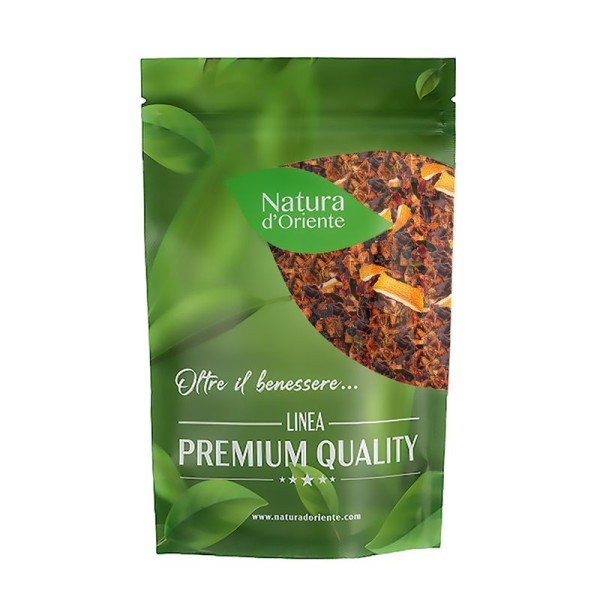








 No reward points for this product.
No reward points for this product.


